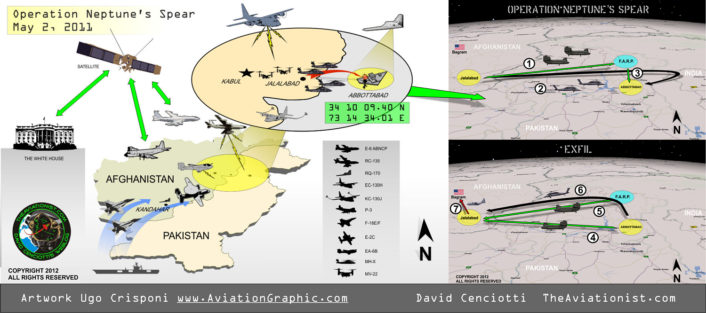Operation Neptune’s Spear exposed the existence of the MH-X Stealth Black Hawk helicopter.
The first photos from the Abbottabad compound where Osama Bin Laden had been killed early in the morning on May 2, 2011, clearly shows something never seen before: the remains of one of the helicopters used by the U.S. Navy SEALs in Operation “Neptune’s Spear”, didn’t seem to belong to any known type.
The horizontal stabilizer and tail rotor of the wreckage depicted in the photographs didn’t seem to be any form of H-60. Both the shape and position were not common to either Black Hawks helicopters and the tail rotor featured a weird cover that could be anything from a stealth cover, to an armour plate to a noise reduction device.
Based on the remains of the tail section this Author tried to imagine what the full stealthy chopper would have looked like after applying some upgrades needed to make it, if not radar-evading, at least a bit quieter.
With some imagination, engine shields, rotor covers, an extra main rotor blade (to slow down the rotor speed making blades quieter), RAM (Radar Absorbing Material) coating, straight lines and what had survived the attempt of the U.S. Navy Seals Team 6 to destroy the chopper, with the help of Ugo Crisponi, an artist at AviationGraphic.com, we created a sketch of the “black”, never seen before, helicopter (that actually resembled more an S-76 than a modified MH-60 Black Hawk so please have a look at a more reasonable shape here.)
Since then, little more has emerged about the black chopper until 2015, when a book titled “Relentless Strike” by Sean Naylor provided some new details about the history of the MH-X.
According to Naylor, the Stealth helicopters that took part in the raid were experimental choppers that had survived a program to make the Black Hawk less visible to radars. Tested by the 160th SOAR in Area 51, Nevada, before the program was cancelled, the two airframes were less maneuverable under certain conditions than the standard MH-60s because of the modifications. Still, in the wake of the successful raid in Pakistan, the program was exhumed, and the “Night Stalkers” flew their “new” MH-Xs to Syria where they took part in the failed raid to free captured American journalist James Foley and other captives from ISIS, on July 4th, 2014.
Although it has never been confirmed, the presence of the MH-X derivatives in Syria was also rumored in the aftermath of a daring raid that killed ISIS high level operative Abu Sayyaf at Deir Ezzor, southeast of Raqqa, in eastern Syria, in the night between May 15th and 16th.

















